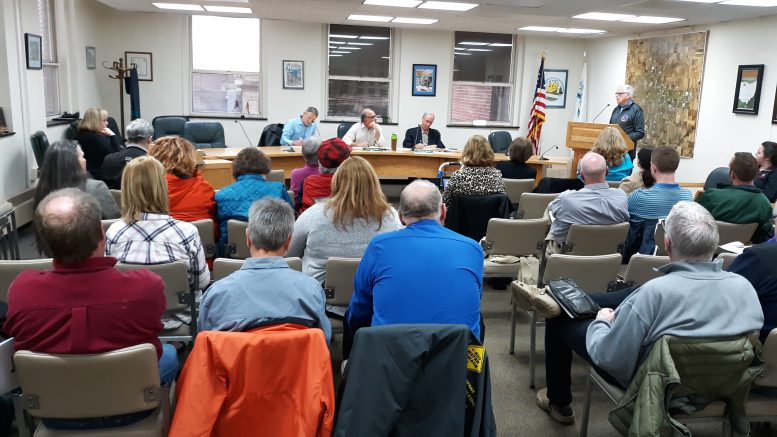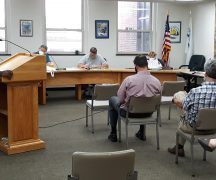By JAN LARSON McLAUGHLIN
BG Independent News
The fifth meeting about rental housing conditions in Bowling Green got off to a strained start Tuesday evening, when a man approached the council table and demanded to know what kind of “racket” the city was trying to pull off.
The man, who signed in as Greg Hoverson, did not speak during the public testimony portion of the meeting.
Also preferring to not speak are members of the local landlords association, who were asked to share their input on a possible rental registration or inspection process.
“We wanted to meet with the property owners. They decided not to,” said council member John Zanfardino, who is chair of the Community Improvement Committee studying the rental housing issue.
“We attempted to have a conversation – that was rejected,” Zanfardino said.
Steve Green, president of the Bowling Green Chapter of the Northern Ohio Apartment Association, sent a letter to Zanfardino explaining the reason for not participating in the public meeting that had been scheduled for March 16. If the landlords felt they were truly being listened to, they would speak, Green said.
However, after reviewing the landlord survey questions, student survey questions, articles published on the topic, and public discussion on the issue, the landlord organization declined.
“It is apparent from review of the aforementioned that the committee (and/or council) has already arrived at a conclusion to the alleged concerns,” Green wrote in his letter.
Green noted that some of the student survey questions had nothing to do with the health and safety of tenants – but were about rental costs or application fees.
“We can all agree that we care deeply about the health and safety of residents,” Green wrote. “Data shows that we as Bowling Green landlords are doing a great job at it. Unfortunately, the committee (with vigilant help from the East Side activist group), is not truly interested in our narrative, but seeks to use it to further their bias.
“The committee has created an echo chamber effect whereby their established beliefs are being amplified by communication and repetition inside a closed system and they are simply seeking information to reinforce their existing views in a conscious exercise of their bias,” he continued.
Green suggested in his letter that education of tenants and city residents would be supported by the landlords.
“Bowling Green property owners will continue to disagree with the committee’s agenda to pass an unnecessary and unwarranted law. We will support, however, education of our tenants and city residents which will do more for the prosperity of our city.”
But at Tuesday’s meeting, Rose Hess, from the East Side organization, reported that hours spent going through records at the Wood County Health Department had yielded many more housing complaints than previously reported.
From 2017 to 2019, there were 101 complaints about problems inside homes, with 142 violations being noted. Ninety-three percent involved rental housing units.
The categories and numbers of complaints included:
- Bed bugs (12) and rodents (13), such as bats in vents, possums and raccoons caught in houses, rodents killed but decomposing in the walls, and cockroaches.
- Mold (26) and odors (11).
- Interior leaks (22).
- General maintenance (10), including peeling paint, standing water in crawl space, human feces in hallway, holes in walls.
- Structural (26), including stairway ready to collapse, missing doors, ceiling sagging in bathroom, windows sealed shut.
- Heating (11), including heat turned off on weekends, no heat in the bathroom, issues with furnace not heating, no heat at all so had to use space heaters.
- Electrical and plumbing (11), including appliances not working, exposed electrical junction box, sewage in hallway, and many outlets not working.
“That’s just a sample of the 142 that we found,” Hess said.
“We can’t say this is all” of the problems, she said. “We do not know what’s inside all of the houses.”
Jan Veitch, also of the East Side group, agreed that rental housing should be regulated for health and safety.
“I believe that renting housing units is a business,” she said. And in many cases, the homes are rented to college students who are naive and not well-informed, Veitch said.
But based on the estimated number of 6,500 rental housing units in Bowling Green, the number of complaints filed by tenants is low, according to Nate Eberly.
“That seems to be a very small number,” he said.
Eberly cautioned City Council members to consider the ramifications of rental housing regulations.
“Be mindful of unintended consequences,” he said. “That cost will be passed on to renters.”
And it could make landlords reluctant to invest in property in Bowling Green, Eberly said.
But Neocles Leontis, another member of the council committee, said the number of tenant complaints are likely far fewer than the actual problems.
“We have to know what’s going on inside – without being able to go inside,” Leontis said of the current predicament. “You are asking us for something we cannot know.”
Leontis also noted that several other communities already have rental housing registration or inspection programs in place.
“Most college towns are already doing this – some for 25 to 30 years,” he said.
Bill Herald, also a member of the council committee, rejected the notion that council shouldn’t be considering action on rental housing without detailed data on the need.
“I think it’s clear enough,” Herald said. “There is room for improvement. I think we’ve moved past ‘Is there sufficient need?’”
The question now is – what is the best measured response by the city, he said.
Herald expressed his disappointment that few landlords were offering input.
“We aren’t getting as much input from landlords as I would like,” he said.
One citizen, Les Barber, said he has not been impressed with the comments that have been expressed by landlords at previous public meetings on the topic.
“I’ve listened to landlord arguments,” he said. “Their arguments are either self-serving or irrelevant.”
Barber questioned why efforts to regulate rental housing in Bowling Green have failed over and over during the past 50 years.
“It’s a big business in Bowling Green,” he said.
Barber, who owns one rental property, said he supports rules to regulate rentals..
“We would be happy to pay a reasonable licensing fee for the good of the community as a whole,” he said.
But Paul Kwapich, of Maumee, who owns Summit Terrace in Bowling Green, warned of the “unintended consequences” of needless regulation.
“The safety of the residents of Bowling Green is of utmost importance,” Kwapich said.
“This is going to be a deterrent for others to make investments in the city,” he said.
And any fees will end up being paid by the tenants.
“This is going to be passed on to the people who can least afford it,” such as students and seniors, Kwapich said.
Chris Ostrowski, who handles property management at Summit Terrace, explained all the additional costs with mandatory inspections. He also said the problem is rental homes owned by out-of-town landlords.
“How do you treat that problem without a huge cost” for all landlords, he asked.
“It’s like hitting a mosquito with a 65-pound sledgehammer,” Ostrowski said.
But members of the council committee said no specifics have been decided about the regulations or the costs.
“Speculating on costs is a bit premature,” Zanfardino said.
City Council President Mark Hollenbaugh shared that concern.
“A lot of assumptions have been made,” he said. “There’s a little bit of hysterics at play.”
Hollenbaugh said his goal for a rental housing program is to improve the quality of life in Bowling Green, without being overly cumbersome.
The next public meeting will be March 16, at 5:30 p.m., followed by another on March 26, at 5 p.m., in council chambers. The committee is charged with coming back to City Council with a proposal by April 6.





